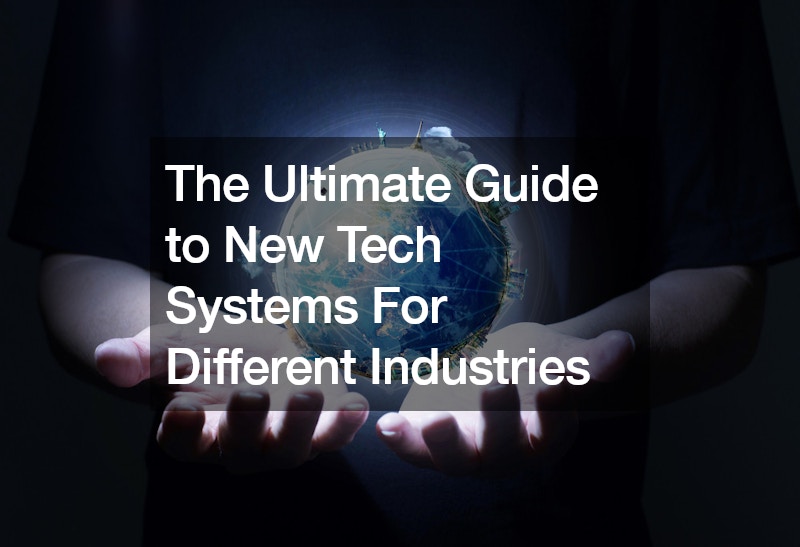The Ultimate Guide to New Tech System For Different Industries

In the dynamic landscape of modern business, the emergence of a new tech system every few months has become the linchpin of progress and innovation. Each industry, with its unique challenges and opportunities, has much to gain from these technological advancements.
This guide will navigate diverse industries, highlighting how they leverage a new tech system to drive efficiency, enhance customer experiences, and, ultimately, redefine their sectors. As we delve into the transformative power of technology, we’ll see how it’s not just about being on the cutting edge; it’s about harnessing these tools to create tangible value and a competitive edge in a rapidly evolving marketplace.
Healthcare Industry

New tech systems are revolutionizing patient care within the healthcare industry, making diagnostics more precise and treatments more effective. Telemedicine platforms facilitate remote consultations, significantly enhancing accessibility to healthcare services, especially in underserved areas. Advanced Electronic Health Records (EHRs) are streamlining patient data management, enabling seamless sharing of patient information across various medical professionals and institutions. Furthermore, predictive analytics powered by artificial intelligence is enabling healthcare providers to make better-informed decisions, thus significantly reducing the chances of diagnostic errors.
In terms of specialized applications, the concept of a pregnancy surrogate has become more manageable and secure through innovative tech systems. Fertility clinics and intended parents can now use sophisticated software for matching, management, and coordination throughout the surrogacy journey. These systems provide a platform for tracking appointments, sharing medical information, and managing financial transactions in a secure environment, giving everyone involved in the surrogacy process peace of mind.
On another front, eye doctors are leveraging cutting-edge technologies to enhance patient outcomes in ophthalmology. From high-resolution retinal imaging to computer-assisted laser surgeries, these tech systems are pioneering new standards for eye care. Specifically, the integration of AI for early detection and treatment recommendation for conditions like diabetic retinopathy and glaucoma is a remarkable example of how technology provides ophthalmologists with tools that save vision and lives.
Legal Sector

The legal sector is not immune to the tidal wave of technological change sweeping across industries. Each year, a new tech system ushers in an era of digital law practice that significantly streamlines case management, document automation, and even client interactions. With legal software, firms can now manage vast caseloads more efficiently and precisely, ensuring that critical information is only a few clicks away.
Take, for instance, the practice among injury lawyers who have begun to rely heavily on a new tech system to manage cases involving personal injury claims. These systems enable lawyers to track the intricate details of each case, including medical records, insurance claims, and legal documentation, all within a centralized database. The use of analytics also allows them to assess the viability of claims and the likelihood of success more accurately.
Moreover, client communication platforms integrated within these systems offer a transparent and continuous line of communication between lawyers and their clients, ensuring that they are kept informed and engaged throughout the legal process. For injury lawyers, the adoption of specialized tech systems can be the difference between winning and settling a case, signaling technology’s critical role in legal negotiations and decision-making.
Construction Industry
The construction industry is experiencing a technological renaissance, fundamentally altering how projects are designed, managed, and executed. The integration of a new tech system has not only improved the precision and efficiency of construction processes but has also greatly enhanced safety protocols. With innovative tools like Building Information Modeling (BIM) software, construction teams can now create 3D models that allow for virtual simulations and analyses before physical work begins, mitigating the risk of errors and reducing waste.
One critical area of advancement is in the realm of surveying. Cutting-edge surveying supplies now incorporate GPS technology, laser scanning, and robotics, offering unprecedented accuracy in land assessment and measurement. These high-tech tools enable quick and precise data collection, which is fundamental for planning and executing construction projects.
By leveraging modern surveying supplies, construction companies can significantly cut down on the time required to survey a site, thus speeding up the entire project timeline without compromising on the exacting demands of such work. In a boon to the interior aspects of construction, tech innovation is also transfiguring cabinet companies. A contemporary cabinet company can utilize advanced design software to produce virtual renderings and prototypes, giving clients a realistic preview of the final product.
Additionally, by incorporating CNC machinery and automated warehouse management systems, these companies can achieve higher production rates with greater accuracy, resulting in custom cabinetry that dovetails perfectly with modern consumer needs. These technological adoptions enable cabinet companies to deliver high-quality, bespoke products efficiently, thereby meeting the growing demand for personalized home and office spaces.
Hospitality Sector

In the bustling world of hospitality, new tech systems are transforming how services are delivered, ensuring exceptional consumer experiences and operational efficiency. The sector is embracing technologies ranging from contactless check-ins to AI-driven personalization, creating a seamless journey for guests from their first interaction to their last.
Hotels, for instance, are implementing smart room systems, allowing guests to customize their stay via mobile devices — controlling lighting, temperature, and entertainment options. These intelligent systems provide convenience for the user and significant energy savings for the establishment. Moreover, the integration of big data analytics helps hotels anticipate guest needs and preferences, tailoring services to enhance satisfaction and loyalty. The restaurant sub-sector, including cafes, has not fallen behind in this technological revolution either.
Many cafes are now utilizing new tech systems like digital menus and ordering kiosks, which streamline operations and reduce waiting times. The data collected through these systems also aid cafe owners in understanding consumer behavior, thereby enabling them to optimize menu offerings and improve the overall customer experience. The synergy between a new tech system and hospitality best practices is laying the groundwork for a more effective, personalized, and enjoyable industry landscape.
Energy Industry
The energy sector is at the forefront of embracing new tech systems to meet the growing global demand for sustainable and efficient power sources. Innovation is driven by the need to reduce carbon footprints and the desire to streamline the production and distribution of energy. In particular, integrating renewable energy sources, like solar and wind power, into the grid embodies this industry’s progressive approach.
Home solar panel installations exemplify one of the direct ways a new tech system is democratizing energy production. These systems afford homeowners the ability to generate their own clean electricity, reduce utility bills, and contribute to a greener environment. Smart grid technology further refines this process, allowing for the efficient distribution of locally generated power and enhancing the stability of the overall energy network.
Furthermore, advancements such as energy storage systems and real-time monitoring software are vital components that help maximize the efficiency of home solar panels. They enable consumers to store excess energy generated during peak sun hours and utilize it when the demand is higher, optimizing energy usage and cost savings. The combined use of these innovative tech systems continues to transform the energy sector, paving the way for a future where sustainable energy solutions are predominant and accessible to all.
Landscaping and Home Design

The landscaping and home design industries are witnessing a significant transformation, thanks to the advent of new tech systems that are enhancing creativity, precision, and client satisfaction. Innovations like 3D landscape design software allow designers to create immersive visualizations, enabling homeowners to envision changes before the physical work commences.
These tools provide a digital canvas to experiment with different layouts, plant selections, and materials, fostering a collaborative design process between the landscaper and the client. Digital platforms are also optimizing project management and operations for landscaping businesses. These systems streamline scheduling, customer communication, and business administration, all while enabling real-time updates and tracking.
Integrating these technological solutions improves business efficiency and elevates the overall customer experience by ensuring projects are completed on schedule and within budget. With the topic of sustainability at the forefront, new tech systems are also empowering eco-friendly practices in landscaping. Water management technologies, such as smart irrigation systems, leverage weather data, soil moisture levels, and evapotranspiration rates to optimize watering schedules and reduce water wastage.
Furthermore, the application of technology extends to tree services, an integral part of landscaping and urban planning. The latest advancements in arboriculture include the use of drones for tree health assessment, aerial mapping for canopy analysis, and specialized software to manage tree inventory and maintenance schedules.
These new tech systems allow for more precise tree care, including disease diagnosis, pruning guidance, and risk assessment, ensuring the health and longevity of trees within our urban landscapes. By implementing these innovative solutions, tree service professionals are not only enhancing the safety and aesthetics of the environment but are also contributing to the ecological well-being of communities.
Cosmetics and Aesthetics
In the realm of cosmetics and aesthetics, the propulsion of new tech systems into the market has revolutionized both the customer experience and the industry’s operational capabilities. These technological advancements have resulted in more individualized, effective treatments and have opened the door to innovations that were once thought to be the preserve of science fiction.
One area within cosmetic aesthetics where new tech systems have made particularly significant strides is cosmetic dentistry. Today, cosmetic dentistry harnesses the power of advanced imaging tech, high-precision tools, and materials that are durable and mimic tooth enamel’s natural appearance.
Digital smile design software allows patients to preview their post-treatment smiles even before the procedures begin, ensuring clear communication and expectations between the dentist and the patient. Custom-fit aligners designed through 3D printing, teeth whitening applications driven by light-based technologies, and CAD/CAM systems that enable the creation of precise crowns and veneers in a single visit all reflect the profound impact new tech systems are having on the practice.
Moreover, these technologies aid in providing a minimally invasive experience while maximizing aesthetic results — key benefits fueling cosmetic dentistry’s growth. With these advancements, cosmetic dentistry is not just improving oral health and aesthetics but also enhancing overall patient confidence and satisfaction.
Fitness and Sports
In the dynamic domain of fitness and sports, new tech systems are playing a pivotal role in reshaping training methodologies, enhancing athlete performance, and providing comprehensive health insights. Wearable technology, such as fitness trackers and smartwatches, has become ubiquitous, allowing athletes and enthusiasts to monitor vital statistics, including heart rate, calorie expenditure, sleep patterns, and overall activity levels.
These devices are backed by sophisticated software platforms that analyze the data, offering personalized training regimes and health recommendations. Moreover, virtual and augmented reality systems are introducing revolutionary ways to engage in fitness, providing immersive experiences that can simulate different environments and track skill development with precise feedback.
Advancements in sports medicine are also worth noting, with a new tech system enabling faster recovery and better preventative care for athletes. The integration of technology in sports medicine is profound, from high-tech compression garments that improve circulation and muscle recovery to advanced imaging technologies that detect potential injuries before they occur.
It’s important not to overlook the emergency rooms in sports facilities, where the availability of a new tech system can be life-saving. In these critical settings, technology aids in providing immediate medical assessments and treatments manage patient records and ensures that care is prompt and effective. The implementation of portable diagnostic tools and telemedicine services also allows for swift specialist consultations, potentially making a significant difference in health outcomes for injured athletes.
As we have explored throughout this document, the integration of a new tech system is fundamentally reshaping industry landscapes. From construction and hospitality to energy, landscaping, and beyond, technology is enabling higher standards of precision, efficiency, and customization. The emergence of advanced technologies has not only heightened the potential for innovation but has also paved the way for more sustainable, user-friendly, and personal experiences across various sectors.
These shifts signal a new era where the boundaries between human ingenuity and technological capability continue to blur, ushering in a future ripe with opportunity and transformation driven by the continual evolution of new tech systems. Let’s embrace this change and look forward to the exciting possibilities it holds.



